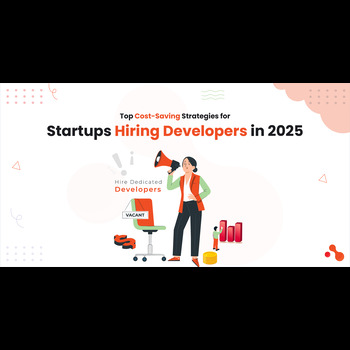


Discover practical, proven cost-saving strategies for startups hiring developers. Learn how to build a high-performing dev team
In 2025, startups are under immense pressure to innovate quickly—without blowing through capital. Traditional in-house development teams are no longer the default. Instead, agile, cost-efficient hiring approaches like remote development, outsourcing, and staff augmentation are becoming the norm.
Let’s explore smart hiring strategies and cost-effective solutions for startups in 2025.
Startups typically face financial constraints, limited brand recognition, and high risks tied to every decision—especially hiring. They struggle to attract top developers and can’t compete with salaries offered by big tech companies. Hiring in-house also brings hidden costs: recruitment, infrastructure, training, and benefits.
Every misstep—like hiring the wrong person or building unnecessary features—can drain time and money. That’s why many startups now ask: How to hire developers on a budget without compromising quality?
The demand for specialized tech talent is growing, but the supply remains limited—driving up developer salaries globally. This shift is pushing startups toward alternative hiring models like:
Freelancers
Outsourcing
IT Staff Augmentation
IT outsourcing revenue is projected to hit $591.24B in 2025.
Offshore software development is expected to grow to $151.9B in 2025.
92% of Global 2000 companies rely on IT outsourcing.
Here’s how startups can save money while still building high-performing dev teams.
Hiring remotely isn’t just flexible—it’s cost-saving. Countries like India and the Philippines offer skilled developers at lower rates.
| Region | Avg. Hourly Rate (USD) |
|---|---|
| USA/Canada | $80–$150 |
| W. Europe | $60–$120 |
| E. Europe | $30–$60 |
| India/PH | $15–$40 |
Freelancers can be hit-or-miss. Instead, use IT staff augmentation agencies that offer pre-vetted developers, ongoing support, and replacements. These agencies help reduce risk and improve development continuity.
Hiring too many developers in the early stages can drain your budget. Instead, build a lean team with essential skills. Expand later as your product scales.
Avoid long-term commitments. With staff augmentation, you can hire on a monthly basis and scale up or down as needed. This reduces fixed costs and keeps your team nimble.
Smarter code = smaller bills. Encourage your devs to use reusable components and set up DevOps pipelines (CI/CD). Automate testing and deployment to save time and reduce bugs.
Pick a hiring model based on your needs:
| Model | Best For | Cost Impact |
|---|---|---|
| Fixed Price | Small, defined MVPs | Predictable but rigid |
| Time & Material | Ongoing development | Scalable, flexible |
| Dedicated Team | Long-term product building | Stable but higher cost |
Before committing, run a short-term pilot to assess quality, communication, and cultural fit. This helps minimize risk and builds trust without upfront commitments.
Outsourcing is no longer just a cost-saving hack—it’s a strategic move in 2025.
Access global talent at lower rates.
Cut infrastructure costs (recruiting, office, admin).
Faster delivery due to proven processes and ready-to-go teams.
Stay focused on core business tasks while experts handle development.
Need flexibility without losing control? Staff augmentation helps you scale quickly, plug skill gaps, and maintain oversight.
Bring in niche experts without full-time hiring.
Scale teams up/down as needed.
Stay agile and budget-conscious.
Follow these best practices for smarter hiring:
Define project scope and required skills upfront.
Pick the right model (outsourced, augmented, or hybrid).
Vet teams carefully—don’t hire based on price alone.
Start small with MVPs or short-term engagements.
Use tools like Trello, Jira, or Slack for communication and tracking.
In 2025, building an in-house dev team from day one is rarely practical. Startups can cut costs, reduce time-to-market, and stay agile by leveraging remote talent, outsourcing, and staff augmentation.
If you’re wondering how to hire developers for your startup, begin with a lean and smart hiring strategy. Prioritize flexibility, cost-efficiency, and technical expertise—and scale as you grow.
Hiring remote developers or outsourcing to vetted agencies offers high quality at a fraction of the cost.
Absolutely. It’s more viable than ever thanks to better tools, global talent access, and rising in-house costs.
Use MVPs, hire based on skills not price, and opt for hybrid models combining in-house leadership with remote support.
Over-hiring, ignoring outsourcing, and underestimating the value of project planning and vetting.
